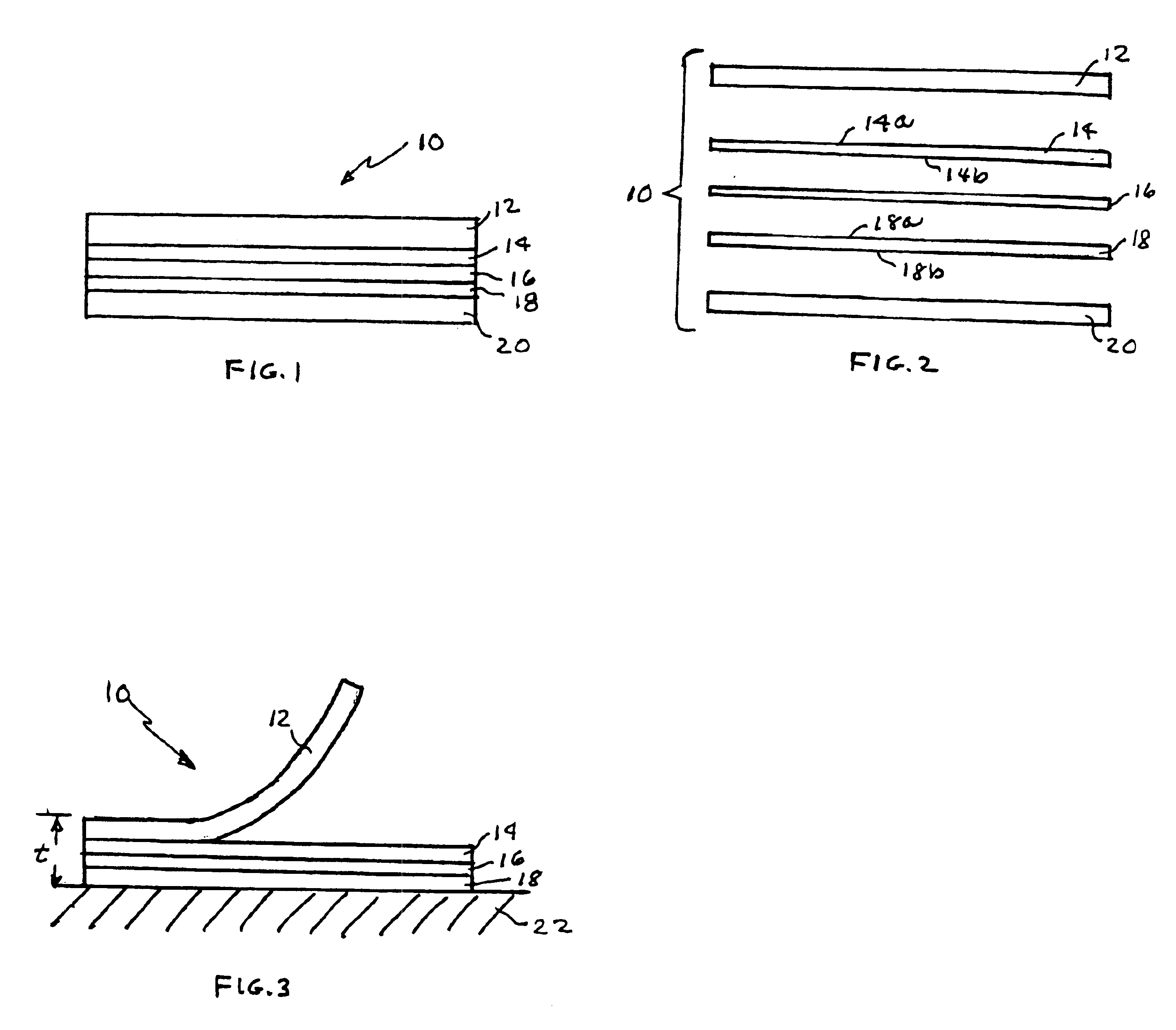Multilayer composite for the dry transfer of graphics to receptive substrates
a technology of graphics and composites, applied in the field of dry transfer of printed graphics, can solve the problems of preventing the use of transparent underlayers, particularly troublesome, and the overall thickness of decals, and achieve the effect of increasing strength
- Summary
- Abstract
- Description
- Claims
- Application Information
AI Technical Summary
Benefits of technology
Problems solved by technology
Method used
Image
Examples
example 1
A multilayer composite was prepared from the following components:A carrier sheet available under product designation “PM 500 Clear Breakcoat” from FLEXcon Inc. of Spencer, Mass., U.S.A. (hereinafter “FLEXcon”) and comprising of 5 mil polyester film with a clear vinyl based breakcoat bonded thereto with a peel strength of 214 grams / inch.Graphics 16 comprising 6 successive applications of UV cured inks.A protective liner available under the product designation “TT-100 EXA-131” from FLEXcon and comprising a one mil polyester film coated with an acrylic pressure sensitive adhesive. The adhesive has an internal strength of 30+ hours and is bonded to the protective liner with a peel strength of 16 grams / inch.
The graphics were printed on the breakcoat and cured. The protective liner was then adhered to the thus printed and cured graphics by means of the adhesive
Component thicknesses measured in mils were as follows:
Carrier sheet5.0 Breakcoat0.4 Graphics2.0 Adhesive0.98Protective Liner1.10...
example 2
A multilayer composite was prepared in the same manner and except for the breakcoat, from the same components as described in Example 1. An acrylic breakcoat was applied to a 5 mil polyester carrier sheet. The coated carrier sheet is available from FLEXcon under product designation PM EXBCA-76. Breakcoat thickness is 0.8 mils, resulting in a total composite thickness of 9.88 mils, with the thickness of the breakcoat / graphics / adhesive transfer to the substrate being 3.78 mils. The breakcoat has a resistance to abrasion of 125 cycles, and is adhered to the carrier sheet with a peel strength of 225 grams / inch. Bond levels to the polished stainless steel plate were as described in Example 1, allowing the graphics to be repositioned on the substrate during a wet out period of 5 minutes, after which the carrier sheet was separated from the breakcoat without disrupting the bond of the adhesive to the substrate.
example 3
A multilayer composite was again prepared in the same manner and except for the adhesive, from the same components as described in Example 1. The protective liner was coated with a 1 mil layer of an aggressive pressure sensitive adhesive. The coated liner is available from FLEXcon under product designation TT-100 V-344. Total composite thickness was 9.48 mils, with the thickness of the breakcoat / graphics / adhesive transfer to the substrate being 3.38 mils.
Within one minute, the bond of the adhesive to the substrate exceeded the peel strength of the breakcoat to the carrier sheet.
In light of the foregoing, it will be seen that the composites of Examples 1 and 2 are ideally suited for use in transferring large area graphics, where repositionability is critical during the application process. Such composites may be employed, for example, in floor graphic applications, as sublayers beneath protective wax top coats. The relatively low abrasion resistance of the breakcoat allows the compos...
PUM
| Property | Measurement | Unit |
|---|---|---|
| thickness | aaaaa | aaaaa |
| thickness | aaaaa | aaaaa |
| thickness | aaaaa | aaaaa |
Abstract
Description
Claims
Application Information
 Login to View More
Login to View More - R&D
- Intellectual Property
- Life Sciences
- Materials
- Tech Scout
- Unparalleled Data Quality
- Higher Quality Content
- 60% Fewer Hallucinations
Browse by: Latest US Patents, China's latest patents, Technical Efficacy Thesaurus, Application Domain, Technology Topic, Popular Technical Reports.
© 2025 PatSnap. All rights reserved.Legal|Privacy policy|Modern Slavery Act Transparency Statement|Sitemap|About US| Contact US: help@patsnap.com

